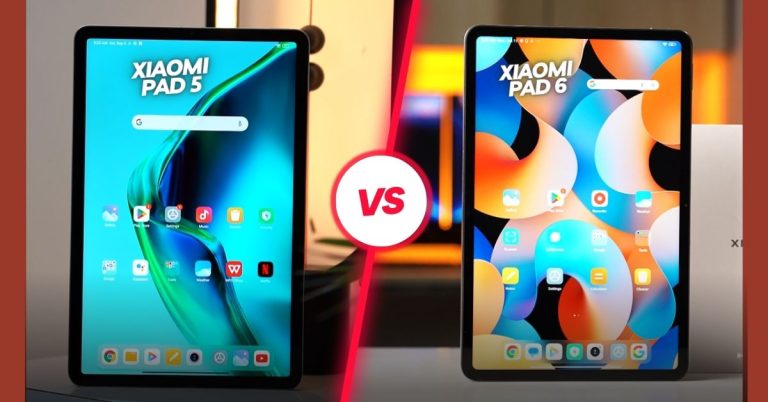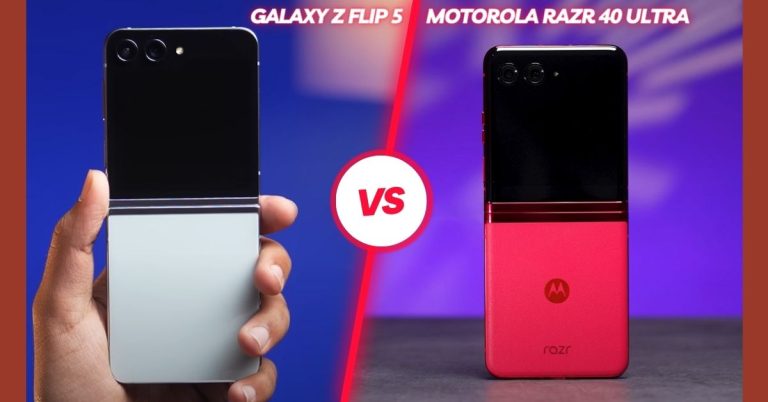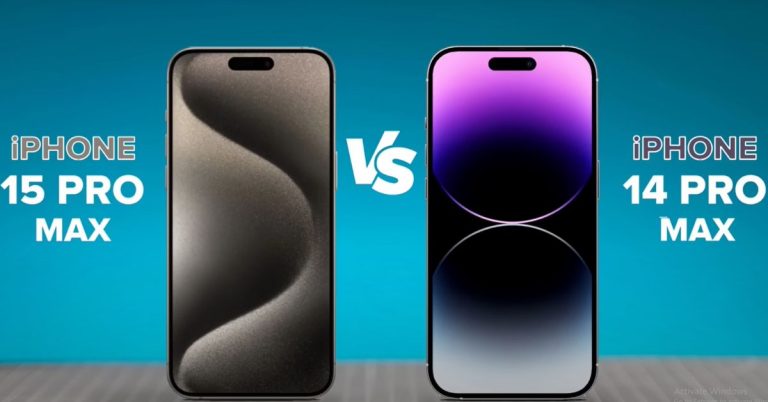Galaxy S25 Ultra Vs 16 Pro Max: Who Gets the Crown?
There are two smartphone kings in the market right now, the Galaxy S25 Ultra and the iPhone 16 Pro Max. Their newly released chips and features awed the world with their fancy events. Revealing amazing specifications which users were surprised by.
Well, the rivalry never ends between these two flagship beasts, and the excitement just keeps growing. Two big names, always compared, always debated, and backed by passionate fans. The hype is real, and everyone wants to know; which one truly stands out? Today, we’re breaking it all down in the ultimate face-off. Let’s not wait any longer and dive right in:
Table of Contents
Galaxy S25 Ultra vs 16 Pro Max: Key Differences
Here’s a few informative key features that makes both Galaxy S25 Ultra and 16 Pro Max apart from their core offerings. They are given down below:
| Galaxy S25 Ultra | 16 Pro Max |
| Gorilla Glass Armor | Ceramic Shield Glass |
| Snapdragon 8 Elite | A18 Bionic Pro |
| Galaxy AI | Apple Intelligence |
| S-Pen | Does not come with stylus |
| Doesn’t have LiDAR | LiDAR Sensor |
| Dedicated Telephoto Lens | No dedicated Telephoto Lens |
| No Dolby Vision | Dolby Vision |
Galaxy S25 Ultra vs 16 Pro Max: Design & Build
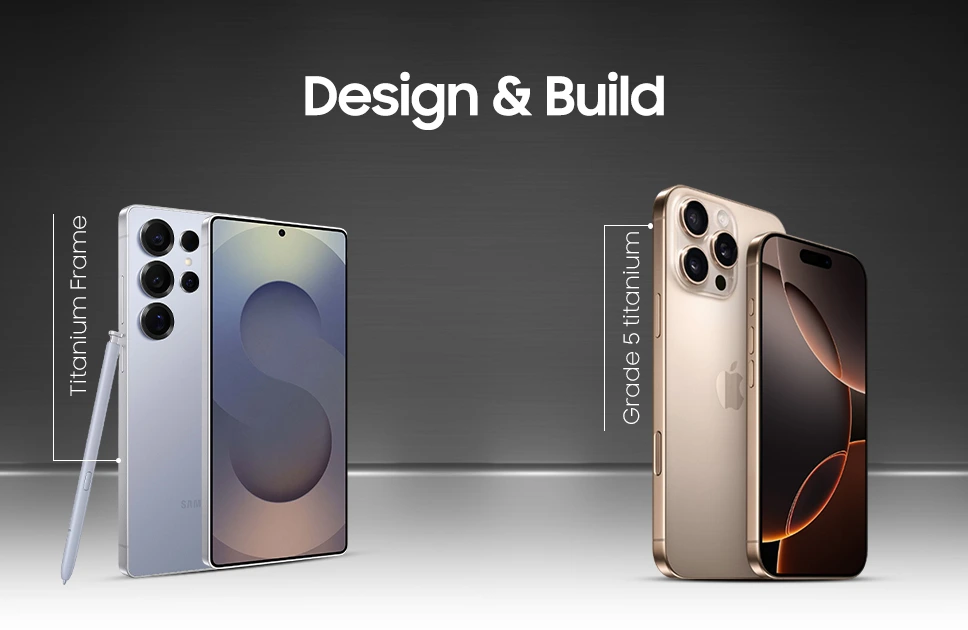
| S25 Ultra | 16 Pro Max |
| Flat frame with rounded corners | Flat frame with curved corners |
| Titanium Frame | Titanium Frame |
| IP68 Rating | IP68 Rating |
At first glance, both the devices made noticeable changes from their predecessors. For the Galaxy S25 Ultra, you get a flatter frame instead of the curved frame seen on S24 Ultra. While its rounded corners look premium and more stylish. There’s also the mini punch-hole camera cutout, which delivers a really good viewing angle for the display.
In contrast, the iPhone 16 Pro Max comes with a similar design like the previous 15 Pro Max. While you do get a new camera control button. Other than this there’s no noticeable changes Apple made with the latest 16 Pro Max.
Galaxy S25 Ultra vs 16 Pro Max: Display
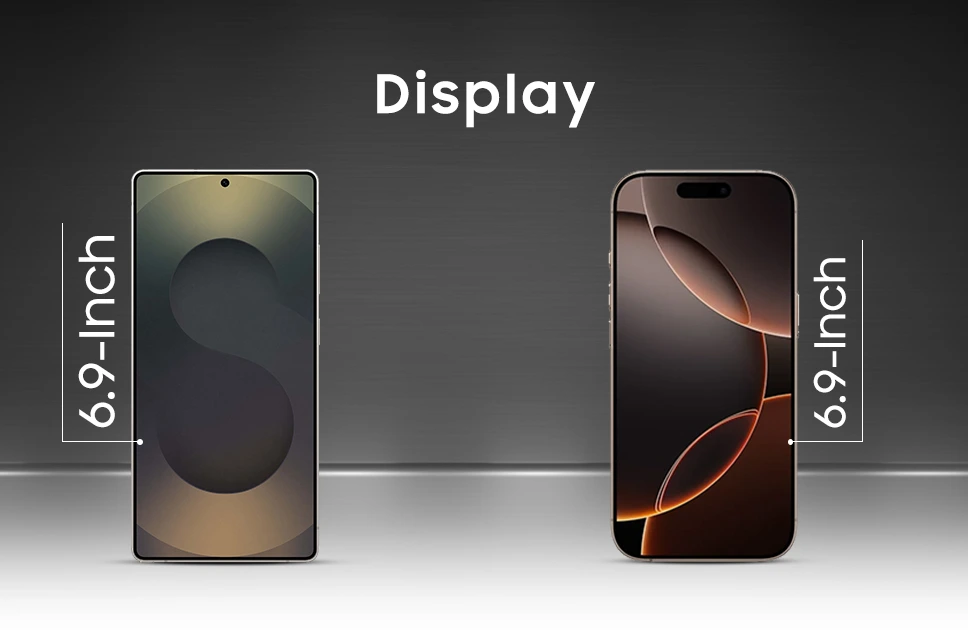
| S25 Ultra | 16 Pro Max |
| 6.9-inch | 6.9-inch |
| 498 ppi density | 460 ppi density |
| 2600 nits | 2000 nits |
Moving on to the display portion, Apple made a huge jump last year with their iPhone 16 Pro Max. By making the phone a bit larger, you get a superb viewing angle from the latest phone from Apple.
S25 Ultra features their same old, Dynamic LTPO AMOLED 2X display with 6.9-inch display/ There’s the last year’s 120Hz refresh rate and HDR10+ support for vibrant visuals for enjoying your movies. Its large, immersive screen is designed for a rich viewing experience, offering deep contrast and brightness for various lighting conditions. Samsung doesn’t come with Dolby Vision while iPhone 16 Pro Max gives you enhanced viewing with Dolby Vision technology.
Now if you look at the iPhone 16 Pro Max, it also delivers really good color accuracy from their large 6.9-inch display. There’s a stunning OLED display, with a 120Hz ProMotion display and Dolby Vision for crisp, lifelike colors. Watching Severance, an Apple-produced thriller, was a treat on this screen (great series by the way, you can check it out). The intense moments felt even more gripping, making the experience truly immersive.
Both screens are nearly identical in size and offer a seamless, high-quality experience, but the iPhone excels with slightly higher peak brightness for better visibility in bright environments. One thing you will miss on Samsung S25 Ultra is the lack of higher dynamic range from Dolby Vision, which luckily iPhone 16 Pro Max is offering and gives you a really good viewing experience.
Galaxy S25 Ultra vs 16 Pro Max: Camera
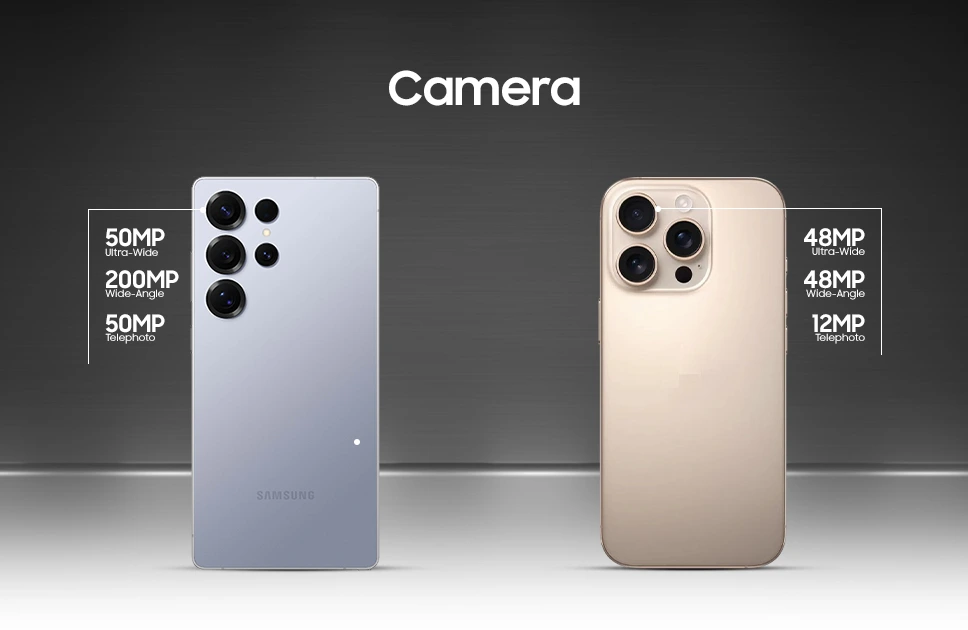
| S25 Ultra | 16 Pro Max |
| 200MP (Wide) + 10MP (Telephoto) + 50MP (Ultrawide) | 48MP (Wide) + 12MP (Telephoto)+ 48MP (Ultrawide) |
| 50MP (Periscope Telephoto) | 12MP (Periscope Telephoto) |
| 12MP (Wide) Selfie | 12MP (Wide) Selfie |
S25 Ultra offers impressive camera versatility with multiple lenses, including a very high-resolution main camera that captures incredibly detailed images. It also features specialized telephoto and ultrawide lenses that bring flexibility to zoom and wide-angle shots.
This Ultra masterpiece from Samsung really stands out with its versatile quad-camera setup, including a 200MP main sensor for ultra-detailed shots and a periscope telephoto lens offering up to 5x optical zoom. Its 50 MP ultra wide lens is perfect for expansive shots, while video recording supports 8K resolution.
On the other hand, iPhone 16 Pro Max emphasizes intuitive control with features like customizable lenses, offering users the ability to fine-tune their photos. Both cameras are excellent for capturing professional-quality photos and videos, but the iPhone’s smart adjustments make it particularly user-friendly. There is no extra telephoto lens as Samsung S25 ultra is offering, so iPhone users will miss features. Though the current 12MP periscope telephoto still delivers really good photos with 5x optical zoom.
One thing Samsung doesn’t have and loses its points in today’s comparison would be LiDAR scanner, which Apple has been providing for a long time since iPhone 12 Pro releases. This enables users to capture greater night mode portraits. You can also create 3D models and measure distances of an object perfectly. Now in this portion, Apple wins the game here for those professionals who might need this feature for making their tasks easier.
Galaxy S25 Ultra vs 16 Pro Max: Performance
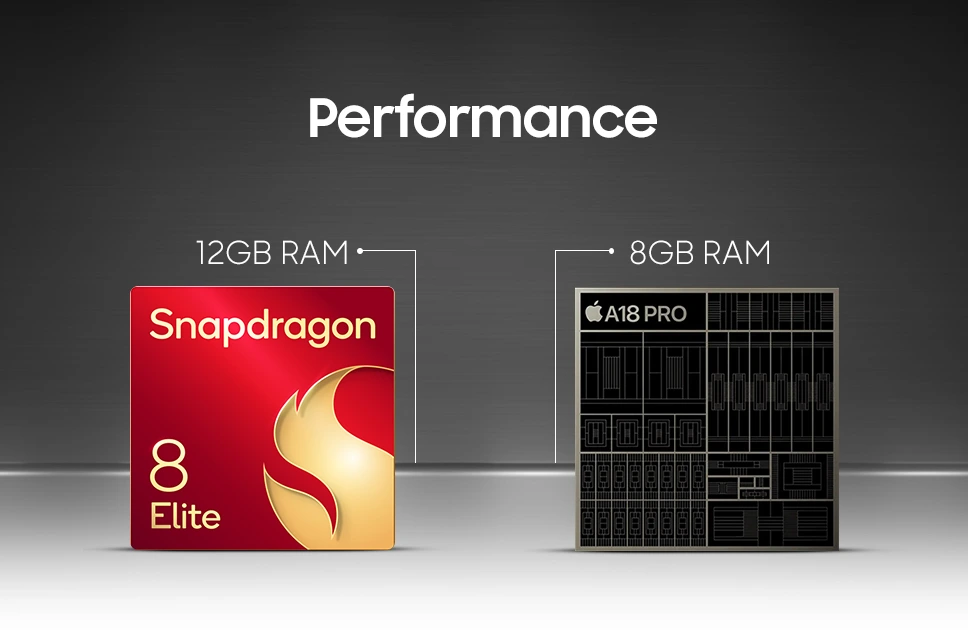
| S25 Ultra | 16 Pro Max |
| Snapdragon 8 Elite | A18 Bionic Pro |
| Adreno 830 | Apple GPU (6-Core) |
| Up to 12GB RAM | Up to 8GB RAM |
After knowing a bit about photography features of both the devices, now let’s understand the overall processing you get from them.
Galaxy S25 Ultra from Samsung, comes with Qualcomm’s latest processor, which is the Snapdragon 8 Elite, a three nano-meter processor capable of delivering up to 4.47GHz processing power to handle multiple tasks all at once. There’s also an Adreno GPU inside, which delivers greater gaming experience.
In comparison, iPhone 16 Pro Max comes with its latest A18 Pro chip, which also comes with a 3 nano-meter architecture. With its Hexa-core processor, you get up to 4.03Ghz processing power, which handles your every task effortlessly. There’s also a 6-Core GPU, ready to handle your hardcore games and high-end photo edits at ease. Do more AI intelligence tasks while keeping your data secured with a 16-core Neural Engine.
Galaxy S25 Ultra vs 16 Pro Max: Gaming
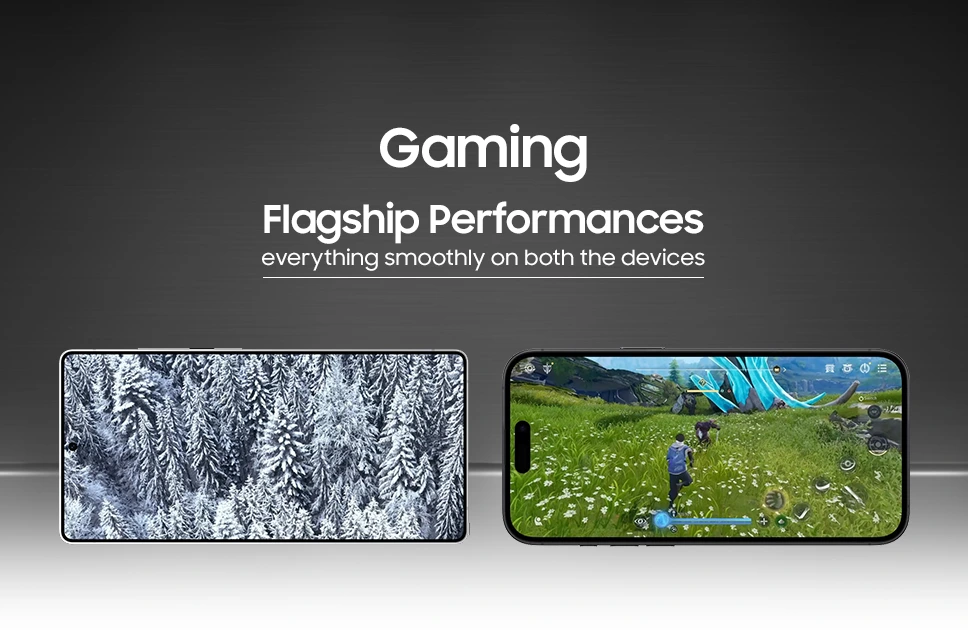
For those who are wondering how good the devices performed in terms of battle royale games like Fortnite and Call of Duty Mobile, you get reliable fps on both of the smartphones. While the 16 Pro Max has advantage in playing directly from Apple Arcade for AAA titles like “Assassins Creed Mirage”. Although, stay worry-free guys as their flagship graphical performances handle everything smoothly on both the devices
Galaxy S25 Ultra vs 16 Pro Max: UI & OS

| S25 Ultra | 16 Pro Max |
| Android 15 | iOS 18 |
| 7-Years OS updates | 5-Years of OS updates |
Moving on, here’s the UI & OS info about both the devices, and there are some really good distinctive features among them.
First of all you are getting the brand new iOS 18 with the iPhone 16 pro max. Giving you more customizable with your apps and even rearranging them with your personal preferences. With a redesigned control center, now you get groups of controls and access widgets smoothly. There’a also Apple’s new Apple Intelligence, which gives you more AI writing tools and summarizes them for quick actions. There’s also fancy new “Genmoji”, which looks a bit cartoonish although works like a charm during imessages.
And I know you might be wondering about the updates, as per Apple’s previous habits, you will get five to six years of iOS updates.
In contrast, with the Galaxy S25 Ultra, you are getting the One UI 7 Skin on top of Android 15. All the widgets and homepage icons are polished versions of the One UI 6. There’s also Samsung DeX support, which lets you easily connect your S25 Ultra into a PC-like experience for improving your productivity. There’s also Galaxy AI, which gives you Google’s circle to search features, lets you remove background noises of a recorded clip with Audio Eraser and many more AI features for greater customization.
As for the updates, Samsung provided a massive 7 years of OS update, which is really a green decision from the company for not making you to buy another
Galaxy S25 Ultra vs 16 Pro Max: Battery
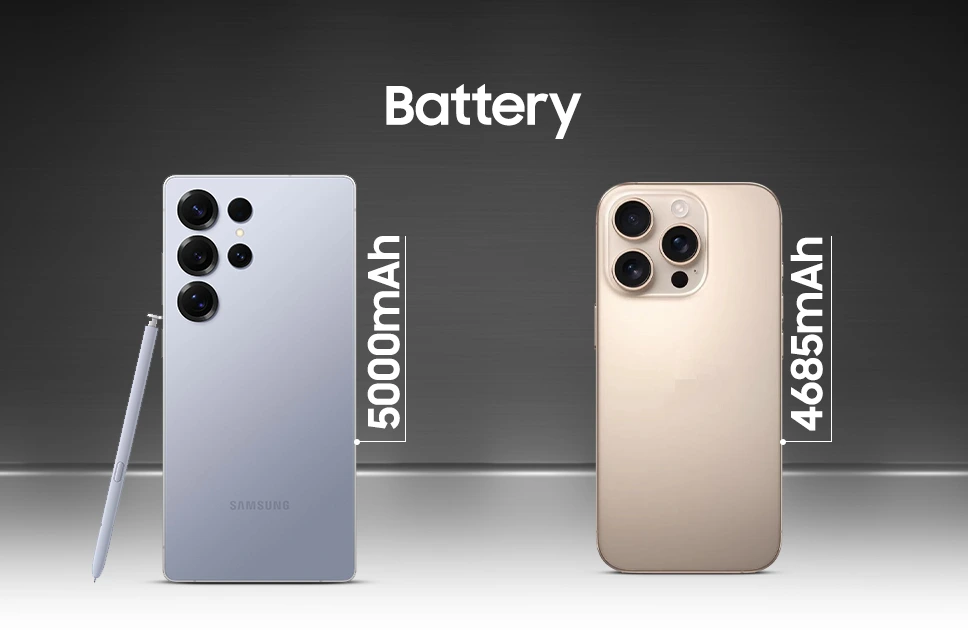
| S25 Ultra | 16 Pro Max |
| 5000 mAh | 4685 mAh |
| 45W Wired | 30W Wired |
| 15W Wireless (Qi2) | Up to 25W MagSafe |
Lastly, let’s talk about both of the device’s battery life and to give you a straight answer, there are some noticeable changes among the two.
With Apple’s iPhone 16 Pro Max, you are getting 4685 mAh capacity, which is around 244 mAh improvement from last year’s 15 Pro Max. You get up to 29 hours of streaming video playback and a massive 105 hours of audio playback. Netflix shows and Spotify music lovers will get a day’s power at ease. There’s also really good charging speed from wired and MagSafe. From the 30W or higher powered wired adapters and up to 25W MagSafe power delivery.
As for the new Galaxy S25 Ultra, you are still getting the same 5000mAh capacity as last year’s S24 Ultra. Which is just in some sense disappointing for those who were expecting a larger battery, although due to the updated Snapdragon chipset you get much more efficient power usage. While you do get a few upgrades with the Qi2 wireless charging, which gives you a little faster wireless power transfers. Besides these minor changes there is nothing to talk about here.
Overall Specs
Here is both the device’s technical information for a better overview of the Samsung Galaxy S25 Ultra specification against Apple’s iPhone 16 Pro Max specs-
| Specifications | Galaxy S25 Ultra | iPhone 16 Pro Max |
| Network | GSM / CDMA / HSPA / EVDO / LTE / 5G | GSM / CDMA / HSPA / EVDO / LTE / 5G |
| Launch | 2025, January | 2024, September |
| Body | 162.8 x 77.6 x 8.2 mm (6.41 x 3.06 x 0.32 in) | 163 x 77.6 x 8.3 mm (6.42 x 3.06 x 0.33 in) |
| Weight | 218 g | 227 g |
| Build | Glass front (Corning Gorilla Armor 2), glass back(Corning Gorilla Armor 2), Titanium Frame | Glass front (Corning-made glass), glass back (Corning-made glass), titanium frame (grade 5) |
| SIM | Nano-SIM + Nano-SIM + eSIM + eSIM (max 2 at a time) – INT | Nano-SIM + eSIM + eSIM (max 2 at a time; International) |
| IP Rating | IP68 dust tight and water resistant (immersible up to 1.5m for 30 min)Stylus | IP68 dust tight and water resistant (immersible up to 6m for 30 min) |
| Display Type | Dynamic LTPO AMOLED 2X, 120Hz, HDR10+, 2600 nits (peak) | Always-on display | LTPO Super Retina XDR OLED, 120Hz, HDR10, Dolby Vision, 1000 nits (typ), 2000 nits | Always-On display |
| Display Size | 6.9 inches (~92.5% screen-to-body ratio) | 6.9 inches (~91.4% screen-to-body ratio) |
| Resolution | 1440 x 3120 pixels, 19.5:9 ratio (~498 ppi density) | 1320 x 2868 pixels, 19.5:9 ratio (~460 ppi density) |
| Protection | Corning Gorilla Armor 2 | Ceramic Shield glass (2024 Gen) |
| OS | Android 15, up to 7 major Android upgrades, One UI 7 | iOS 18 | upgradable to iOS 18.3.1 |
| Chipset | Qualcomm Snapdragon 8 Elite (3 nm) | Apple A18 pro (3nm) |
| CPU | Octa-core (2×4.47 GHz Oryon V2 Phoenix L + 6×3.53 GHz Oryon V2 Phoenix M) | Hexa-core (2×4.05 GHz + 4×2.42 GHz) |
| GPU | Adreno 830 | Apple GPU (6‑core GPU) |
| Memory Card slot | Not Available | Not Available |
| Internal | 256GB 12GB RAM, 512GB 12GB RAM, 1TB 12GB RAM | 1TB | 256GB | 512GB |
| Main Camera | 200 MP, f/1.7, 24mm (wide), 1/1.3″, 0.6µm, multi-directional PDAF, OIS10 MP, f/2.4, 67mm (telephoto), 1.12µm, PDAF, OIS, 3x optical zoom50 MP, f/3.4, 111mm (periscope telephoto), 1/2.52″, 0.7µm, PDAF, OIS, 5x optical zoom50 MP, f/1.9, 120˚ (ultrawide), dual pixel PDAF, Super Steady video | 48 MP, f/1.8, 24mm (wide), 1/1.28″, 1.22µm, dual pixel PDAF, sensor-shift OIS12 MP, f/2.8, 120mm (periscope telephoto), 1/3.06″, 1.12µm, dual pixel PDAF, 3D sensor‑shift OIS, 5x optical zoom48 MP, f/2.2, 13mm (ultrawide), 0.7µm, PDAFTOF 3D LiDAR scanner (depth) |
| Main Camera Features | Laser AF, Best Face, LED flash, auto-HDR, panorama | Dual-LED dual-tone flash, HDR (photo/panorama) |
| Main Camera Video | 8K@24/30fps, 4K@30/60/120fps, 1080p@30/60/240fps, 10-bit HDR, HDR10+, stereo sound rec., gyro-EIS | 4K@30/60/120fps, 1080p@30/60/240fps, 10-bit HDR, Dolby Vision (up to 60fps) |
| Selfie Camera | 12 MP, f/2.2, 26mm (wide), 1/3.2″, 1.12µm, dual pixel PDAF | 12 MP, f/1.9, 23mm (wide), 1/3.6″, PDAF, OIS |
| Selfie Camera Features | HDR, HDR10+ | HDR, Dolby Vision HDR, 3D (spatial) audio |
| Selfie Camera Video | 4K@30/60fps, 1080p@30fps | 4K@30/60fps, 1080p@30fps |
| Sound | Stereo speakers | Stereo Speakers |
| 3.5mm Headphone Jack | Not Available | Not Available |
| Sound Features | 32-bit/384kHz audio | Tuned by AKG | Spatial Audio and stereo recording | Dolby Digital Plus | Apple Lossless |
| WLAN | Wi-Fi 802.11 a/b/g/n/ac/6e/7, tri-band, Wi-Fi Direct | Wi‑Fi 7 (802.11be) with 2×2 MIMO |
| Bluetooth | 5.4, A2DP, LE | Version 5.3 |
| Positioning | GPS, GLONASS, BDS, GALILEO, QZSS | Precision dual-frequency GPS (GPS, GLONASS, Galileo, QZSS, BeiDou, and NavIC) |
| NFC | Available | Accessory Identification NFC |
| USB | USB Type-C 3.2, DisplayPort 1.2, OTG | USB-C connector Charging | DisplayPort | USB 3 (up to 10Gb/s) |
| Sensors | Fingerprint (under display, ultrasonic), accelerometer, gyro, proximity, compass, barometer | Face ID | LiDAR Scanner | Barometer | High dynamic range gyro | High-g accelerometer | Proximity sensor | Dual ambient light sensors |
| Features | Samsung DeX, Samsung Wireless DeX (desktop experience support)Ultra Wideband (UWB) supportCircle to Search | Apple Intelligence | Supporting vision | |
| Battery | Li-Ion 5000 mAh | Li-Ion 4685 mAh |
| Charging Info | 45W wired, PD3.0, 65% in 30 min15W wireless (Qi2.1)4.5W reverse wireless | 25W wireless (MagSafe), 15W wireless (China only)15W wireless (Qi2)4.5W reverse wired |
| Colors | Titanium Silver Blue, Titanium Black, Titanium White Silver, Titanium Gray, Titanium Jade Green, Titanium Jet Black, Titanium Pink Gold | Black Titanium, White Titanium, Natural Titanium, Desert Titanium |
| Performance Tests | AnTuTu: 2207809 (v10)GeekBench: 9846 (v6)3DMark: 6687 (Wild Life Extreme) | AnTuTu: 1838828 (v10)GeekBench: 8606 (v6)3DMark: 4731 (Wild Life Extreme) |
Verdict
Long story short, both the devices are truly remarkable from their own offering. You get the picture of how well Samsung provides its Android ecosystem while ensuring amazing performance for productivity and performance. On the other hand, Apple did an awesome job bringing updated power and design while keeping the value premium as ever.
Whether you require the best camera features or want the updated AI requirement, both 16 Pro Max and S25 Ultra deliver relevant results. You do get a higher battery compared to iPhone 16 Pro Max. Although the sudden removal of bluetooth features with its renowned S-pen is a downer. If you consider these two downsides, the S25 Utlra can be a good option for those who are used to Android phones.
Above all, keep your eyes on Apple Gadgets blog page for remaining up to date about any kind of gadgets and accessories.
Get the Samsung Galaxy S25 Ultra, if:
- You need the best visual experience from the Galaxy King;
- You are okay with same old Galaxy Eco-system experience;
- You require greater build quality from Samsung in their flagship.
Get the 16 Pro Max, if:
- You want to remain in the iOS ecosystem;
- You love the exclusive new iPhone design with camera;
- You want the best performing Apple phone in the market right now.

Rabbi Rahman enjoys talking about tech, gadgets and especially smartphones. He’s been writing about them for four years . His favorite topic is discussing innovations in devices, engaging in conversations with others who share his passion for technology.


